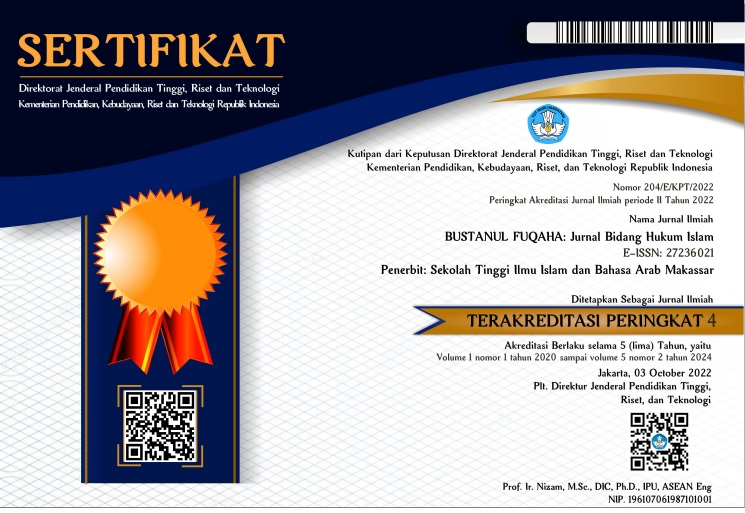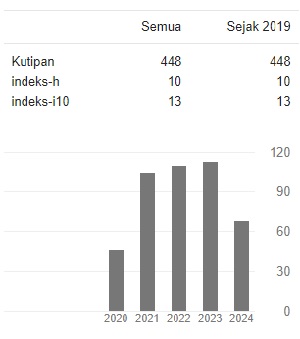Penggunaan Cadar dan Konsekuensinya bagi Muslimah (Analisis Komparatif Antara Wahdah Islamiyah dan Jemaah Tablig)
The Use of the Veil and Its Consequences for Muslimah (Comparative Analysis Between Wahdah Islamiyah and the Jemaah Tablig)
DOI:
https://doi.org/10.36701/bustanul.v2i3.398Keywords:
Veil, Muslimah, Masturah, Wahdah Islamiyah, Jemaah TabligAbstract
This study aims to identify and understand the differences in the use of the veil and its consequences for Muslimah Wahdah Islamiyah and Jama'ah Tablighi. Problems in research; (1) what is the use of the veil and the consequences for Muslimah Wahdah Islamiyah?; (2) what is the use of the veil and the consequences for Muslimah Jama'ah Tablighi? This research uses descriptive qualitative research with field research methods (Field Research). Using normative, historical and sociological approaches. Primary data sourced directly from sources. Secondary data in the form of literature and documents in the form of books, articles and others. The results showed that Muslimah Wahdah (MW) and Masturah had different views on the law of wearing the veil. Muslimah Wahdah (MW) places greater emphasis on independence for all cadres and sympathizers and even Muslim women in general to make their own choices. Choose an opinion that requires the wearing of the veil or choose an opinion that views the sunnah. There is no coercion and intervention. While Masturah is more likely to adhere to the opinion that requires the wearing of the veil, especially to all Muslim women of the Tablighi Jamaat. As for the selection of the model and the color of the veil used, there were no significant differences between these two Muslim da'wah movements. However, Muslimah Wahdah (MW) is more lenient in this regard. The consequences they face when wearing the veil are generally the same. Challenges from the family and community that they must face.
Downloads
References
Abdurrahman, Haris. Geliat Dakwah dari Yayasan Fathul Mu’in hingga Wahdah Islamiyah (1988-2004). Buraydah: t.p., 2020.
Al-Asqalani, Ahmad bin Ali Hajar. Syarah Shahih al-Bukhari. Jakarta: Pustaka Iman, 2018.
al-Hajjaj, Imam Muslim. Sohih Muslim. Beirut: Dār Ihya Turats Araby. tt
al-Jazāiri, Abdurrahman. al-Fiqh ‘Alā Mazāhibi al-Arba’ah. Mesir : Darul Hadis. tt
al-Nawawi , Al-Majmu’ Syarh al-Muhadzab. Damaskus: dār al fikr. tt.
Arnold, Thowas W, Sejarah Maulana Muhammad Ilsyas: Mempelopori Khuruj fi Sabilillah, Bandung Pustaka Ramadhan, 2019.
Dokumen Wahdah, 2002.
Hilmi, Ahmad. Hukum Cadar Bagi Wanita. Cet. 1; Jakarta Selatan: Rumah Fikih Publishing, 2019.
https://republika.co.id/berita/nlvfq3/bercadar-wajib-sunah-atau-mubah (diakses kamis, 21 Oktober 2021 M)
Isnawati, Aurat Wanita Muslimah. Cet.1: Jakarta Selatan: Rumah Fiqih Publishing, 2019
Kementerian Agama, R I. “Al-Qur’an Dan Terjemahan.” Bandung: CV Mikraj
Khazanah Ilmu, 2014.
Mufid, Ahmad Syafi’i. Perkembangan Paham Keagamaan Tradisional Indonesia. Jakarta: Kementrian Agama RI: Badan Litbang dan Diklat Puslitbang Kehidupan Keagamaan, 2011.
Muhammad, Ibnu Majah. Sunan Ibnu Majah. Mesir: Dār Ihya al-kutub. tt
Normani, Muhammad Mansur. Riwayat Hidup Syeikh Maulana Ilyas Rah (Bandung: Zaadul Ma’had, t.th.
Nugroho, Indonesia Islam in a Global Context: A Pholyphony of Voices Title: Pesona Jemaah Tablig dalam, 4th Internasional symposium of journal Antropologi Jakarta- Indonesia. http;//antropologi.fib.ugm.ac.id/artdetail.php?id=1
Wahdah Islamiyah “Sejarah-Berdiri-Manhaj”, situs Resmi WIM http://wahdahmakassar.org/sejarah-manhaj 1
Wahdah Islamiyah “Visi utama Wahdah Islamiyah”, situs resmi WIM,https://wahdah.or.id/visi-misi/ (diakses 15 Juni 2017)














